| A
R T I C L E S |
New Collectibles •05/25 - NECA Sesame Street: Count Von Count Ultimate Action Figure
•04/25 - Reaction Sesame Street: Big Bird and Snuffy •03/25 - NECA Sesame Street: Ernie Ultimate Action Figure, Bert Ultimate Action Figure
•03/25 - Boss Studios Fraggle Rock: Boober Action Figure, Wembley Action Figure, Mokey Action Figure, Sprocket Action Figure •08/24 - Reaction Sesame Street: Big Bird, Mr. Hooper, Sherlock Hemlock, Super Grover |
||
|
|
|

It's Not Easy Being Blue
By
Stephanie Harrigan
LIFE MAGAZINE
July, 1990
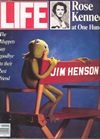 As
a celebrity, Jim Henson seemed vague and uncertain. He was just
barely in sight, hovering on the fringes of public recognition.
When he appeared as himself on television, he came across merely as a
nice, boring man. His voice was high and reedy, his manner intense but
somehow languid. All in all, he looked at first glance like the sort of
aging hippie you might find manning a booth at a crafts fair, passively
trying to interest you in his line of Hobbit candles or handcrafted kaleidoscopes.
As
a celebrity, Jim Henson seemed vague and uncertain. He was just
barely in sight, hovering on the fringes of public recognition.
When he appeared as himself on television, he came across merely as a
nice, boring man. His voice was high and reedy, his manner intense but
somehow languid. All in all, he looked at first glance like the sort of
aging hippie you might find manning a booth at a crafts fair, passively
trying to interest you in his line of Hobbit candles or handcrafted kaleidoscopes.
So when he died, the effect was odd. Like millions of others, I suppose, I received the news at first with mild puzzlement ("Jim Henson? The Muppet guy?") and then went back to my day, not anticipating the sense of loss that slowly began to overtake me as the thought sunk in. It was not grief - just an unnerving pang. I kept remembering myself as an anxious new parent, sitting there in the sleepy afternoon quiet, the weight of a child in my lap, watching the glum, quizzical faces of the Muppets on "Sesame Street." I thought of Bert and Ernie tucked into their monogrammed twin beds, Kermit the Frog sitting on a swamp log moodily playing the banjo, my two-year-old daughter running up to a garbage can in the park, shouting, "Oscar! Oscar!"
The Muppets were Jim Henson's invention, and it was his spirit, as well as his hands and voice, that animated them. Until he died so unexpectedly at age 53 (of pneumonia brought on a by a rampaging strep infection), no one had apparently given much thought to the idea that the Muppets might, in any sense, be mortal. Henson's death made this curious notion unavoidable. After all, he did not just perform Kermit, he was Kermit. He was Ernie as well. He was Rowlf the Dog. He was the Swedish Chef, the jowly curmudgeon known as Waldorf, the porcine space commander Link Hogthrob. Two weeks after his death, in the headquarters of Jim Henson Productions in Manhattan, there was an air of exponential loss. Henson was dead, and his many characters were held in some kind of eerie suspension. No one was certain if they could ever truly spring to life again.
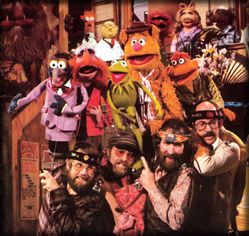 "I
saw Kermit the Frog in 'The Muppets Take Manhattan' the other day,"
Michael Frith, the company's executive vice president, said, "and
he shone as a true movie star. Kermit was becoming richer and richer
as the years wore on - more layered, more multidimensional. When
you try to figure out where this deep, welling sadness comes form, it's
from the loss of Jim's talent."
"I
saw Kermit the Frog in 'The Muppets Take Manhattan' the other day,"
Michael Frith, the company's executive vice president, said, "and
he shone as a true movie star. Kermit was becoming richer and richer
as the years wore on - more layered, more multidimensional. When
you try to figure out where this deep, welling sadness comes form, it's
from the loss of Jim's talent."
The seat of the Henson entertainment empire is an elegant brownstone in New York City that was built in 1928 as the home of a banking tycoon. It has since, as one staffer said, been "Muppetized." A central staircase curves around a mobile that features miniature Muppets cavorting up and down a series of hot-air balloons, and the building is crowned by a stained-glass skylight representing a swamp scene as it would be perceived by a low-lying frog.
The day I was there, not yet two weeks after Henson's death on May 16, a display cabinet in the entrance hall contained an empty director's chair, a photograph of Henson, and framed letters of sympathy from Ronald Reagan and President Bush. The Walt Disney Company, which has recently structured a deal to acquire Henson's company, his creative services and the rights to his non-Sesame Street characters, had sent over an outsize condolence card. On its cover Mickey Mouse sat with his arm around the spindly shoulders of a bereaved Kermit. Upstairs there was a growing file of letters from children. One of them read, "God must have needed Muppets in heaven."
Stranded in the midst of all the playful decor - the Muppet wallpaper, the Kermit telephones, the plastic figures of Fozzie Bear of Gonzo or Big Bird in clusters on the window ledges and on the surfaces of every desk - Henson's colleagues were heartbroken and disoriented, still speaking of him half the time in the present tense, still waiting to be convinced he was really dead. With striking consistency, they remembered him as a "father figure" and, it seemed, almost as a spirit guide - a quiet, authoritative, beloved man without a trace of aggression but with "a whim of steel."
"It's easy to eulogize somebody," said Frank Oz, who had been Bert to Henson's Erie, Miss Piggy to his Kermit. "Jim was not perfect. But I'll tell you something - he was a close to how you're supposed to behave toward other people as anyone I've ever known."
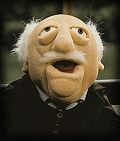 The
range of Henson's imperfections included a wandering eye for women and
a cheerful lust for material objects. He was known for his Kermit-green
Lotus, his many homes in New York, London, Greenwich and Malibu, and his
classical antiques, which he proudly displayed alongside leftover props
from various Muppet movies. And his famous consideration and patience
could sometimes prove to be annoying traits when it came time for an urgent
executive decision. But otherwise he was as he appeared, and as
one would have hoped him to be.
The
range of Henson's imperfections included a wandering eye for women and
a cheerful lust for material objects. He was known for his Kermit-green
Lotus, his many homes in New York, London, Greenwich and Malibu, and his
classical antiques, which he proudly displayed alongside leftover props
from various Muppet movies. And his famous consideration and patience
could sometimes prove to be annoying traits when it came time for an urgent
executive decision. But otherwise he was as he appeared, and as
one would have hoped him to be.
He was playful, benign, tirelessly inventive and only rarely a bit "snarky." (To express anger, he might turn the pages of a magazine faster than usual). His favorite expression was "hmmmmmm." He encouraged silliness and chaos. Like Kermit, the undaunted host of "The Muppet Show," he needed a storm to be the calm center of.
"Without Jim," Frank Oz says, "I'm a pretty serious person at times. He was the leader always, but he allowed us to play. We had so much fun. I can't begin to tell you the fun."
Oz had worked with Henson for 26 years, since he was 19, and there are people willing to argue that the two of them had developed into a comedy team as enduring as Laurel and Hardy or Burns and Allen. Henson and Oz both had the Muppeteer's trademark physique - tall enough to hoist the creatures into camera view above a built-up stage set, supple enough to endure the crouched and contorted postures often required for staying out of sight.
The peculiar physical demands of Muppetry only reinforced the sense of familial closeness that pervades Henson's shop. Some Muppets, glorified sock puppets like Kermit, could be operated by a single performer, but the more complicated characters were team efforts. One performer would be the left arm, say, another the right arm and head. Together, they would synchronize their movements by watching their composite creature on a hidden video monitor. As often as not, the job of the Muppeteers was to blend their beings into one, and part of the trauma they felt at Henson's death had to do with the realization that a piece of themselves had been torn away. When I asked Richard Hunt, whose characters included Scooter and Beaker and Statler, what it had been like to work with Henson, he said, "We shared the same heart."
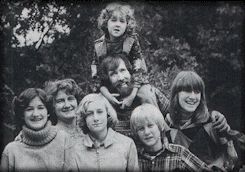 Jim
Henson had a real family as well as an honorary one. He and his
wife, Jane, had five children, all of them now filmmakers, artists, designers,
producers or puppeteers. "We grew up in TV studios," Cheryl
Henson, his second child, recalls. "We all enjoyed being around
him, and one of the best ways for us to be around him was to work with
him - because when he was working he was always at his peak."
Jim
Henson had a real family as well as an honorary one. He and his
wife, Jane, had five children, all of them now filmmakers, artists, designers,
producers or puppeteers. "We grew up in TV studios," Cheryl
Henson, his second child, recalls. "We all enjoyed being around
him, and one of the best ways for us to be around him was to work with
him - because when he was working he was always at his peak."
There is an unforgettable family photograph showing a clean-shaven Henson - in publicity shots of that early period he looks a little like Montgomery Clift - waggling a prototype of Kermit the Frog in front of his firstborn baby, Lisa, as if to set into her mind the idea that she would be sharing her existence with an alternative life-form.
The Muppets were never an overbearing presence in the lives of the Henson children, but their father's creative energy was an enthralling thing to be around. "Dad was such a huge inspiration," recalled his son Brian, a puppeteer. "My father had wonderful goals and wonderful dreams. And when he died, I realized they had become mine. And I saw that in virtually everyone in the company. So I think, in some ways, he's still there in everyone. We've lost our focus temporarily but we'll get that back right away. He's still there."
Jim Henson's lingering presence had been in powerful evidence the week before at his memorial service, an epic and almost unbearably moving event in which this shy puppeteer was laid to rest as if he had been the world's last living vestige of goodness and whimsy. You would have had to have been a Muppet yourself not to feel the hair stand upon the back of your neck when Big Bird walked into the vastness of the Cathedral of St. John the Divine and sang a quavering rendition of Kermit's theme song, "It's Not Easy Bein' Green."
Henson had planned part of the service himself four years earlier. He had asked that no one wear black and suggested that he would appreciate it if there was a Dixieland band present to pay "When the Saints Go Marching In"; both requests were duly honored. He had also written letters to his children to be opened after his death, and Brian Henson read parts of them that day in the cathedral. Henson's advice from the beyond sounded as casual as if he had just then scribbled in on a napkin - "Please watch out for each other and love and forgive everybody. It's a good life, enjoy it" - but this unassuming message rang out in that cathedral full of true believers like a mighty testament.
Why had he taken such pains, when he was not, yet ever 50, to orchestrate his own departure? Henson's friends are divided about whether he had a "premonition," but he did have a growing, brooding interest in mortality. His work shows it, particularly the dark and masterful European folk tales that make up "The Storyteller," a short-lived TV series that was revered by critics but never made a ratings impact. And then there was "Labyrinth," an ambiguous tale about a stolen child starring the patently unwholesome David Bowie.
"The film wasn't received terribly well to start with," Brian Henson says. "And I think that was the closest I've seen him to turning in on himself and getting quite depressed. It was a rather bad time, and he went to the south of France for a few days to wallow in it. He told me he was writing. I never asked him what he was writing - but those were the letters."
Toward the end of his life Henson was restlessly in search of deeper themes, but he never turned his back on the bright legacy of the Muppets. It was to guard that legacy that he had begun the negotiations with Disney. "He wanted those characters to be around when he wasn't," says Kevin Clash, one of Henson's younger Muppeteers, "and the main company that could do that was Disney."
Disney had dearly wanted the licensing rights to all the Henson creations, including the "Sesame Street" characters, but Henson refused, concerned that without the income from merchandising, the future of the public TV show might be threatened. "He wouldn't even discuss how it might work," said Joan Ganz Cooney, who founded "Sesame Street." "He said it was a deal-breaker."
Just a week or so before he died, Henson, in an uncharacteristically idle moment, filled out a life expectancy quiz in "Esquire," indicating he believed he would live to be 83 or 84. He also joked about buying an island and turning it into an Old Puppeteers' Home.
And then he came down with what he thought was the flu, and three days later he lay unconscious on his deathbed as his family and friends bent down and whispered their shocked goodbyes.
"He had a very keen sense of his immortality," Jane Henson said, sitting in the second-floor conference room underneath a painting in which Kermit the Frog stood in for Gainborough's Blue Boy. "He knew the mortality was coming, but he loved what life had to offer and was looking forward to what was coming next. He was mystical, yes, but in an indirect and naive way." She lifted her head and looked around the paneled room. "I feel that he is working on other things right now."
Jane had taken a seat on a hideous-looking black chair, a prop left over from Henson's movie "The Dark Crystal," where it served as the throne of the evil Skeksis, a shuffling bone heap that had taken eight puppeteers to operate. Jim Henson's widow is a quiet, commanding woman, and she took possession of the chair with some deliberation, as if she meant to vanquish its dark associations.
At the time of Jim's death, the Hensons had been separated for five years, but before that their life together had encompassed the raising of five adult children and the entire evolutionary span of the Muppets. One of Jim's first creations had been a nonspecific green animal named Kermit - only later would it be classified as a frog - assembled from his mother's cast-off coat and a bisected Ping-Pong ball. Jim, Jane, and Kermit debuted together in a spirited, anarchic puppet show called "Sam and Friends" that aired over a Washington, D.C., station with a talking skull named Yorick. Sam was a bald, dish-mouthed humanoid in a sport coat and tie. Jim and Jane operated the characters, working together in cramped proximity to bring them to life.
"What Jim saw," Jane Henson said, "is that the puppet is as powerful as a human being. And in fact is more powerful - less concerned about what it looks like, more direct, more able to go to the heart of things."
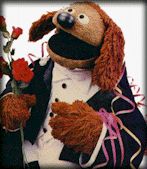 Jim
Henson changed puppets forever, changed them into Muppets. One look
at Henson's creations and few people ever wanted to see a stiff, dangling
marionette again. His puppets were designed for the close-in scrutiny
of the television camera. Their eyes were uncannily expressive, their
wide mouths moved in perfect sync with their words. They did not
just represent living beings - they were alive themselves.
Jim
Henson changed puppets forever, changed them into Muppets. One look
at Henson's creations and few people ever wanted to see a stiff, dangling
marionette again. His puppets were designed for the close-in scrutiny
of the television camera. Their eyes were uncannily expressive, their
wide mouths moved in perfect sync with their words. They did not
just represent living beings - they were alive themselves.
Or so we can't help believing. "There is something about putting life in the inanimate doll," Jane Henson said. "There's a bit of divinity in it that all puppeteers understand."
That was the thought that kept coming back to me as, later that day, I went on a tour of the workshop where the Muppets are made. Amid all those half-assembled creatures of flocked foam and slush latex, a puppetmaker named Ed Christie showed me a file cabinet where the characters from "Sesame Street" - the actual working Cookie Monsters and Oscars and Grovers - were kept when not in use.
"Here's the real Bert," he said. "And down there is the real Ernie."
He took them out of their drawers and held them up, Bert with his familiar scowling face and repose, their mouths open, their arms hanging idly at their sides, they were creepy. They seemed not only inert but bewitched, frozen under some dark spell. And it seemed at that moment that only Jim Henson, whose genius had created them, and who was now gone, could ever release them.
"That's all they are," Ed Christie said, "just lumps of fabric." I watched as he put Ernie back into the drawer, next to a Ziploc bag filled with spare rubber duckies, and closed the file.
|
|
|
home | news | collectibles | articles | forum | guides | radio | cards | help
Fan site Muppet Central created by Phillip Chapman. Updates by Muppet
Central Staff. All Muppets, Bear
Muppet Central exists to unite fans of the Muppets around the world. |